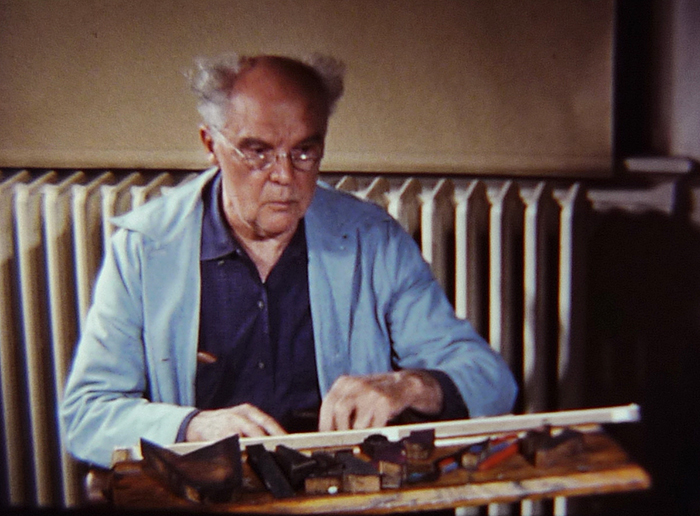The University of Virginia Library will preserve and digitize a 1960 film about artist and former U.Va. professor Charles W. Smith, thanks to a grant from the National Film Preservation Foundation.
The 16mm film, “Charles Smith’s Block Painting,” was made in 1960 by U.Va.’s former Division of Extension and General Studies. It documents Smith’s artistic process, which involved a modified version of wood block printing.
Smith, who was born in 1893 and died in 1987, was the first chair of the McIntire Department of Art in the College of Arts & Sciences, said Steven Villereal, audiovisual conservator in the library’s Preservation Services department, who applied for the grant.
“The film shows him working in his studio and is likely the only moving image made of this artist and his process,” Villereal said. “It’s a little hokey in the way that educational films of the era are, but it functions as an interesting historical document and artifact about the artist.”
A copy of the film resides in the Albert and Shirley Small Special Collections Library, which houses both Smith’s papers and the records of the Division of Extension and General Studies, the entity that eventually evolved into the current School of Continuing and Professional Studies.
The $5,000 grant from the foundation, a nonprofit created by Congress to save the country’s film heritage, will allow the library to contract a lab to create a new 16mm copy of the film, new copies of its component tracks and a digitized version that could be posted online.
“The film is about the artist himself, but also goes into detail about his technique,” Villereal said. “It could be seen as an example of a mid-century educational film, but I think the most interesting thing about it is what it tells us about Charles Smith.”
Smith was born in Augusta County, where he learned the tools and methods his father used as a patternmaker at a local foundry. In the summer, he took art courses at U.Va. and also later studied at the Corcoran School of Art in Washington, D.C., and at Yale University. He returned to U.Va. as an art instructor after World War I, and would later work as a graphic artist in Richmond and as a wooden block printing artist whose works were shown in New York galleries. He returned to U.Va. in 1947 to chair the Art Department.
Though he continued doing traditional wood-cut work throughout his career, Smith became more artistically adventuresome toward the middle of the century, Villereal said. After carving blocks into geometric shapes, Smith would paint each one for each impression and layer the blocks anew for each print, creating as many as several hundred abstract compositions from one set of blocks.
His art drew critical acclaim, and the Museum of Modern Art, The Solomon R. Guggenheim Museum, The Art Institute of Chicago and the National Gallery of Art in Washington, D.C., obtained prints of his work.
The 1960 film was screened at U.Va. after its creation, and a copy seems to have made its way to renowned Polish graphic artist Wolciech Fangor, who used it in instructional classes at the Warsaw Academy of Fine Arts, Villereal said.
“It was shot on reversal stock, like you would shoot a home movie,” he said. “There was never a negative; you’d just make a new print on reversal stock. So we can basically see how many times they made prints of it, because the lab paperwork was all there with the film.”
Villereal said the library will plan to screen the film after it is restored, and that Special Collections is considering an exhibition on Smith and his work in 2014.
Media Contact
Article Information
September 25, 2012
/content/special-collections-restore-film-documenting-uva-artist-professor-charles-w-smith

